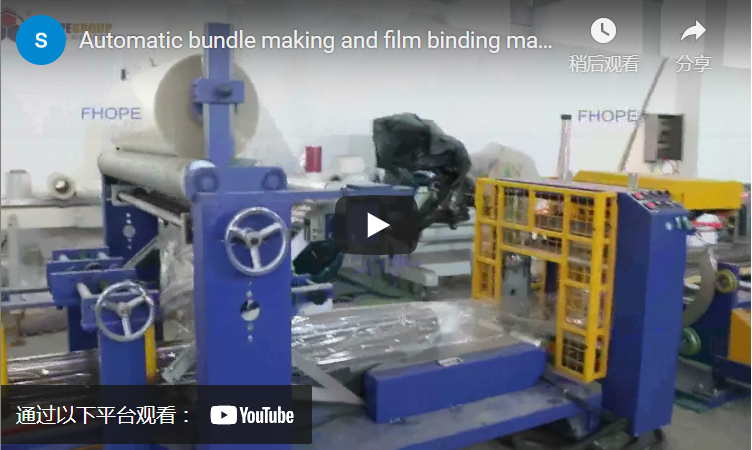In modern manufacturing environments, particularly those dealing with elongated products like tubes, pipes, or aluminum profiles, efficient end-of-line packaging is critical for maintaining throughput and reducing labor costs. Manual bundling and wrapping processes often create bottlenecks and inconsistencies. This article provides a technical overview of an automated inline packaging solution: the Automatic Bundle Making and Film Binding Machine, designed to streamline these operations.
1. System Overview and Workflow Integration
This automated packaging system is engineered for seamless integration directly downstream from production lines such as extrusion presses, rolling mills, or cutting stations. Its core function is to receive finished products, organize them into pre-defined bundles, and securely wrap them with stretch film.
The typical operational workflow proceeds as follows:
- Infeed: Products arrive from the production line onto the machine's infeed conveyor.
- Counting & Collation: Precise sensors (often optical or laser-based) count the items. A collation mechanism arranges the correct number of pieces into the desired bundle configuration (e.g., rectangular, hexagonal).
- Bundle Formation: The collated items are formed into a tight, stable bundle.
- Film Binding: The formed bundle moves to the wrapping station. A stretch film dispenser applies film circumferentially under controlled tension, securely binding the bundle. The film is then automatically cut and sealed.
- Outfeed: The finished, wrapped bundle is discharged onto an outfeed conveyor or directly into a subsequent bagging or palletizing system.
2. Technical Specifications and Design Parameters
Understanding the machine's capabilities requires examining its key technical data. While specifications vary by model and manufacturer, typical parameters include:
- Product Compatibility:
- Materials: Steel tubes, copper pipes, aluminum profiles, PVC conduits, wooden rods, etc.
- Cross-section: Round, square, rectangular, hexagonal, custom shapes.
- Bundle Dimensions:
- Length Range: Typically 1 meter to 6 meters (customizable).
- Cross-section Range (Bundle): e.g., Min 50mm x 50mm, Max 300mm x 300mm (examples, specific to model).
- Maximum Bundle Weight: e.g., up to 500 kg (dependent on design).
- Performance:
- Throughput: e.g., 2-5 bundles per minute (depends on bundle size and wrap cycles).
- Counting Accuracy: Typically ±0 pieces.
- Film Wrapping:
- Film Type: Stretch Film (LLDPE).
- Film Width: e.g., 100mm - 250mm.
- Film Thickness: e.g., 17 - 35 microns.
- Wrapping Tension: Adjustable via control panel.
- Control System:
- Controller: PLC (Programmable Logic Controller), common brands include Siemens, Allen-Bradley, Mitsubishi.
- Interface: HMI (Human-Machine Interface) Touch Screen for parameter setting, diagnostics, and operation monitoring.
- Power & Utilities:
- Electrical: e.g., 400V, 3-Phase, 50Hz (region-specific).
- Compressed Air: e.g., 6-8 bar (if pneumatic actuators are used).
3. Key Components and Structural Design
The reliability and performance of the machine hinge on its core components and overall construction:
- Infeed/Outfeed Conveyors: Typically roller or belt conveyors designed to handle the weight and length of the products without causing damage. Material: often galvanized steel or heavy-duty polymers.
- Counting Sensors: Photoelectric sensors, laser distance sensors, or vision systems ensure accurate piece counts before bundling.
- Collation & Bundling Mechanism: May involve pneumatic pushers, servo-driven arms, or specially shaped channels to arrange products precisely. Robust frame construction is essential to handle forces during bundle formation.
- Film Wrapping Unit: Features a rotating ring or arm carrying the film roll dispenser. Includes pre-stretch mechanism (often motorized) to optimize film usage and wrapping tension control. Automated film clamping, cutting, and heat-sealing/wiping ensure a clean finish.
- Control Panel & HMI: Centralized control with intuitive touchscreen interface for setting bundle recipes (number of pieces, dimensions), adjusting wrapping parameters, viewing alarms, and running diagnostics.
- Safety Systems: Interlocked guarding, emergency stop buttons, light curtains (optional) ensure operator safety according to relevant standards (e.g., CE, ISO).
- Frame and Structure: Typically built from heavy-gauge carbon steel, often powder-coated for durability. Stainless steel may be used for contact parts in specific applications.
4. Advantages of Automated Inline Bundling
Integrating such a system offers significant operational benefits:
- Increased Throughput: Eliminates manual handling bottlenecks, matching the output speed of modern production lines.
- Labor Savings: Reduces the need for manual counting, bundling, and wrapping, freeing up personnel for higher-value tasks.
- Consistency and Quality: Ensures uniform bundle size, tightness, and wrap quality, improving product presentation and protection during transit.
- Enhanced Safety: Reduces risks associated with manual lifting and repetitive motions. Fully guarded systems protect operators during operation.
- Material Optimization: Controlled film stretching mechanisms can reduce film consumption compared to manual wrapping.
- Data Integration: PLC controls allow for integration with plant-level MES (Manufacturing Execution Systems) for production tracking and reporting.
5. Operational Considerations and User Experience
From an operational standpoint, these machines are designed for industrial environments:
- Ease of Use: Modern HMIs provide graphical interfaces for straightforward operation and recipe management. Stored recipes allow for quick changeovers between different product sizes or bundle configurations.
- Changeover: Depending on the design, adjustments for different product dimensions or bundle sizes might involve manual adjustments (e.g., guide rails) or be fully automated via servo motors controlled from the HMI. Minimizing changeover time is a key design goal.
- Maintenance: Requires routine checks on sensors, pneumatic components (if applicable), film cutting blades, and lubrication of moving parts. Diagnostics via HMI assist in troubleshooting. Access panels are typically designed for ease of maintenance.
- Reliability: Built with industrial-grade components for continuous operation in demanding manufacturing settings. Manufacturer support and spare parts availability are important considerations.
6. Conclusion: Streamlining End-of-Line Packaging
The Automatic Bundle Making and Film Binding Machine represents a significant advancement over manual methods for packaging long products. By integrating counting, bundling, and wrapping into a single automated sequence directly within the production flow, manufacturers can achieve substantial improvements in efficiency, consistency, safety, and cost-effectiveness. Its robust design, coupled with advanced control systems, makes it a valuable asset for industries producing tubes, pipes, profiles, and similar materials, ensuring products are securely packaged and ready for shipment with minimal manual intervention. This technology, often sourced from specialized manufacturers like the one highlighted from China, is pivotal in optimizing modern production logistics.


